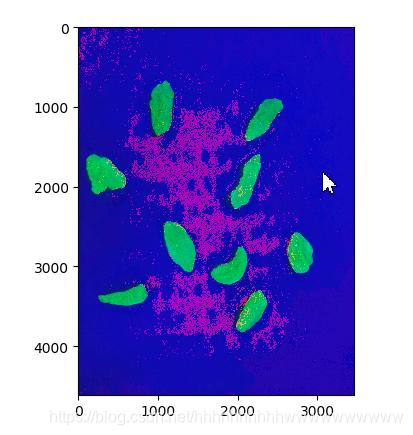Python-OpenCV分割图像查枸杞的个数
图像分割算法有分水岭算法、斑点计数算法、霍夫圆/椭圆算法、轮廓检测算法等。在本文中,本例使用了轮廓检测和分水岭算法。
第一步导入依赖
from __future__ import print_function
import numpy as np
import cv2
import matplotlib.pyplot as plt
from skimage import io
from skimage.morphology import watershed
from skimage.feature import peak_local_max
from scipy import ndimage
创建可视化图像函数:
def show(img):
plt.imshow(img)
plt.show()读取图像
#load
fp = "1.jpg"
img = cv2.imread(fp)
show(img)
print(img.shape)对图像进行预处理。步骤包括:
- HSV,这是人眼感知的颜色模型。
- 阈值技术,通过选定的阈值像素强度将图像转换为二值图像(即只有2个像素值(0或255))。
- 模糊图像,以删除图像中不必要的斑点。
#preprocessing the image
hsv = cv2.cvtColor(img, cv2.COLOR_BGR2HSV)
show(hsv)
h, s, v = cv2.split(hsv)
show(s)
_, thr = cv2.threshold(s, 0, 255, cv2.THRESH_BINARY + cv2.THRESH_OTSU)
show(thr)
blur = cv2.medianBlur(thr, 5)
show(blur)
现在我们使用轮廓检测,在我们“模糊”的图像中找到枸杞。为了去除小的和无关紧要的轮廓,我们只选择那些面积大于2000的轮廓(任意值,是超参数)。
contours, hierarchy = cv2.findContours(blur,cv2.RETR_TREE,cv2.CHAIN_APPROX_SIMPLE)
copy2 = img.copy()
count = []
for x in contours:
area = cv2.contourArea(x)
if area > 2000 :
count.append(x)
cv2.drawContours(copy2, count, -1, (255,0,0), 3)
show(copy2)
print("number of lemons found via contour detection = ", len(count))
现在我们使用分水岭算法来分离相互接触的枸杞(如果有的话)。
copy3 = img.copy()
D = ndimage.distance_transform_edt(thr)
localMax = peak_local_max(D, indices=False, min_distance=300,
labels=thr)
markers = ndimage.label(localMax, structure=np.ones((3, 3)))[0]
labels = watershed(-D, markers, mask=thr)
ws = len(np.unique(labels)) -1
copy3[labels == -1] = [255,0,0]
print("no. of lemons found via watershed algorithm = ", ws)
计算两种方法的平均值:
ans = int((len(count) + len(np.unique(labels)) -1) / 2)
print("number of lemon segments detected = ", ans)
show(copy2)
完整代码:
from __future__ import print_function
import numpy as np
import cv2
import matplotlib.pyplot as plt
from skimage import io
from skimage.morphology import watershed
from skimage.feature import peak_local_max
from scipy import ndimage
def show(img):
plt.imshow(img)
plt.show()
#load
fp = "1.jpg"
img = cv2.imread(fp)
show(img)
print(img.shape)
#preprocessing the image
hsv = cv2.cvtColor(img, cv2.COLOR_BGR2HSV)
show(hsv)
h, s, v = cv2.split(hsv)
show(s)
_, thr = cv2.threshold(s, 0, 255, cv2.THRESH_BINARY + cv2.THRESH_OTSU)
show(thr)
blur = cv2.medianBlur(thr, 5)
show(blur)
contours, hierarchy = cv2.findContours(blur,cv2.RETR_TREE,cv2.CHAIN_APPROX_SIMPLE)
copy2 = img.copy()
count = []
for x in contours:
area = cv2.contourArea(x)
if area > 2000 :
count.append(x)
cv2.drawContours(copy2, count, -1, (255,0,0), 3)
show(copy2)
print("number of lemons found via contour detection = ", len(count))
copy3 = img.copy()
D = ndimage.distance_transform_edt(thr)
localMax = peak_local_max(D, indices=False, min_distance=300,
labels=thr)
markers = ndimage.label(localMax, structure=np.ones((3, 3)))[0]
labels = watershed(-D, markers, mask=thr)
ws = len(np.unique(labels)) -1
copy3[labels == -1] = [255,0,0]
print("no. of lemons found via watershed algorithm = ", ws)
ans = int((len(count) + len(np.unique(labels)) -1) / 2)
print("number of lemon segments detected = ", ans)
show(copy2)
输出的结果如下:
参照:
- 点赞
- 收藏
- 关注作者










评论(0)